This site contains affiliate links. As an Amazon Associate, I earn a commission from qualifying purchases at no extra cost to you. Full Disclosure Here.
About a month ago, I learned that it was possible not only to test old alkaline batteries to see if they are still are usable but also that, with the right type of charger, you can bring dead batteries back to life and that you can actually recharge alkaline batteries. To be quite honest, I was blown away.
Being a dutiful citizen of the world, when a flashlight, computer mouse or portable electronic gizmo such as a remote control stopped working, I dumped the old batteries into my recycle box and installed some new ones. Of course not being wasteful, I favored the use of rechargeable batteries and was quite proud of my collection of various sized Eneloop batteries which hold their charge for up to three years, even while sitting on the shelf.
First, a quick note on the “tools used” for this project:
- Cheap Battery Tester: Check this one out on Amazon.
- Universal Rapid Battery Charger: Check it out at this Amazon listing.
- Inexpensive Battery Storage Case: This is the one used in this tutorial.
A LADY ON A MISSION
Do you every get a bug in your bum and decide that nothing will stop you from the mission or task at hand? Well, that was me. I wanted to prove to myself that old alkaline batteries were still usable and further, as Dennis Evers (Preparedness is Fundamental) says, you can have free batteries for life.
The first thing I needed to do was to gather up the gear:
Old “dead” alkaline batteries
Battery tester simple enough to use without a Ph.D. in electronics
Battery charger designed specifically for alkaline batteries
Test gear such as flashlights, remote controls, wireless headphones and more
Simple enough although I did have to purchase the tester and the charge. But more on that later.
SORT THROUGH THE BATTERIES AND CULL THE DUDS
For years I have been saving all of my old batteries in a box in the garage, thinking that one of these days I would find someplace to recycle them. Where I live that is easier said than done so the box was pretty darn full which was great because that meant I had a lot of raw material to work with.
My Box of “Dead” Batteries
While waiting for my battery tester and alkaline charger to arrive, I sorted through the box, weeding out any leakers as well as odd ball batteries such as cell phone and hearing aid batteries. According to Wikipedia, the reason a battery leaks is this:
As batteries discharge — either through usage or gradual self-discharge — the chemistry of the cells changes and some hydrogen gas is generated. This out-gassing increases pressure in the battery. Eventually, the excess pressure either ruptures the insulating seals at the end of the battery, or the outer metal canister, or both. In addition, as the battery ages, its steel outer canister may gradually corrode or rust, which can further contribute to containment failure.
Leaked Battery – Yuck
Surprisingly, most of the batteries in my box were clean. Something to keep in mind as you go through the sorting process is that if there is even a single leaker in the box, the residue can spread on to other batteries so it helps to have a rag handy to wipe each battery off to see if it is okay. If you even suspect that a battery has leaked, or if shows any rust or corrosion, don’t take a chance. Throw the baddies back into the recycle box.
WHO SAYS THAT DEAD BATTERY IS REALLY DEAD?
I purchased an inexpensive battery tester from Amazon. There was nothing special about it and it was easy to use. Plus, it had the ability to test 9V batteries as well as button batteries and the traditional AA, AAA, C and D sized batteries.
Simple Battery Tester
I then set to work, testing each and every battery in my box. Much to my surprise, there were a number of batteries that tested “fully charged”. It is interesting to note that many were 9 Volt batteries that came out of one of my carbon monoxide detectors. This leads me to believe that the detector is bad and not the batteries.
Furthermore, I now believe that what commonly happens is that, for example, a remote control or flashlight is dead. You dump the batteries into the recycle box and install new ones. Easy peasy. But in truth, perhaps only a single battery of the 2 or 3 are bad so in effect, you are dumping out 1 discharged battery and 2 or 3 perfectly usable batteries. I even proved this myself. Since I now keep one of these $8 testers in my desk drawer, when my wireless mouse died a couple of days ago, I found that only one of the two AAA batteries that I had removed was dead. The other was showing almost a full charge. Go figure.
The other thing, and something that makes me feel careless and stupid, there were some perfectly good rechargeable batteries in the box. Now, how the heck did that happen?
These were good!
And I thought these batteries were dead.
LET THE RECHARGING BEGIN
After reading reviews on various rechargers, I settled on the Maximal Power FC999 Universal Battery Charger. It wasn’t the most expensive available but according to a couple of the reviewers, this unit was exactly the same as a higher priced model. The difference was that this one is black and the other one was gray.
Maximal Power FC999 Universal Battery
Now here is the deal with this charger. It has four separate charging chambers that operate independently of each other. This means that you can mix and match battery sizes (AA, AAA, C, D) without a problem. It also has a center 9V battery chamber but I have not been able to figure out whether that piggybacks upon one of the adjacent chambers or whether it operates separately.
Note: this charger can also be used to charge Ni-cd and Ni-MH batteries but I only tested it on Alkaline batteries. There is a slider switch that allows you to select the type of batteries you are charging – they can not and should not be mixed and matched by type (although, as I mentioned, various sizes of the same type work just fine.)
There is no question that I experienced a bit of trepidation when I inserted the batteries into the charger for the first time. But there was no smoke and no explosion so I continued on.
A few seconds after you insert the batteries, the tester will recognize the status and the LED window will either say “CHA” (for charging) or “BAD” (for sorry, this is a bad battery and it cannot be charged). In addition, the following lights will glow:
- Red – Charging
- Green – Fully Charged
- Red Flashing – BAD
As I mentioned above, each of the four chambers operates independently so you could have a combination of these three options all going at once.
There is a chart in the manual that indicates that an AAA battery will take 2.5 hours to charge, an AA 5 hours, a C size 6 hours, and a D sized 10 hours. In my experience, however, they charge to the fully-charged, green light stage a lot sooner than that. Now here is the thing. Once fully charged, the charger switches to a trickle charge to keep the battery “at its optimum capacity” whatever that means.
My experience is that if you leave the recharged batteries in the charger overnight – or say for about 10 or 12 hours – you will get a much stronger charge. I say this because I first tested some batteries right after the green light came on. On my tester, they would register at about the half way mark in the fully-charged area. If I put them back in the charger, the green fully-charged light would come on right away but when I took them out the next morning, the tester showed them about 90% charged.
These batteries have been re-charged and are now usable
After doing this a few times, I realized that next on my bucket list was a tester that would give me the actual voltage of the re-charged battery. My brother and nephew – both electronics wizards – have one and tell me that is the only way to truly test the remaining juice left in a used battery.
OTHER TESTING NOTES
The little manual that came with the charger stated that alkaline batteries can be charged to 75 – 90% of their original capacity. It further said that the batteries should be fully drained before recharging but I found that as a practical matter, the fully drained batteries came up “BAD” and could not be recharged at all.
There is one more rather important note that I want to make. I checked on my recharged batteries about two weeks after storing them in a box in my utility cupboard. Much to my surprise, there were some new leakers. Now whether these were overlooked initially (had I wiped away the residue not realizing they were compromised) or a byproduct of the charging process – I do not know. Even more curious, they were all the Costco Kirkland brand batteries.
I had good luck charging the Duracell batteries
The manual also indicates that alkaline batteries should not be recharged more than 30 times. 30 times – holy moly – that seems like a lot of charging to me. For now, I will charge them once until I go through the pile and then start anew. But 30 times? I am going to play it safe and protect my devices by recharging no more than a dozen times if that.
SO REALLY, HOW DID THEY WORK?
Using the recharged batteries on low power devices such as mini LED flashlights and of course, my computer mouse, worked great. As a matter of fact, I can not tell the difference between the recharged Alkalines and standard rechargeables. On the other hand, the Survival Husband uses wireless headphones to watch TV and the recharged alkalines only last abut 8 hours as opposed to the typical 15 to 20 hours with standard Ni-mh rechargeables.
Flameless candles have burned steadily for 5 days
The recharged 9V battery worked especially well on my little Blocklite flashlight. This little flashlight has been on 24/7 since March 9th and today for the first time I noticed the LEDs starting to fade when all six LEDs are on. When I turn the switch to 2 LED mod, it is as bright as ever.
Blocklite Mini Flashlight in Day 7
Clearly, for now, at least, it appears that the recharged alkaline batteries are best suited for low-drain devices.
STORING THE BATTERIES
I purchased these inexpensive storage cases for my recharged batteries. They are really quite handy and I like that the six individual cases interlock and connect together to make a larger case. The rest of my spares are in the plastic pencil case you see pictured above.
I like these mini storage cases.
THE FINAL WORD
For a total investment of about $34, I now have what for all intents and purposes, a lifetime of free batteries. The reason I say “lifetime” is that my friends have indicated a willingness to give me all of their dead batteries and you can bet that many will still be either good as is or eligible for recharging.
Would I trust these recycled batteries in a survival situation – sure, if that is all I had, But of course, that is not the case. I still have a large supply of brand new alkaline batteries in all sizes plus a good supply of standard rechargeables (you know how I love those Eneloop rechargeables).
But as spare batteries to use day to day, heck, these are great. As my tests have proven, a recharged alkaline battery can keep a small LED flashlight going to over a week and a computer mouse for much longer than that. As a matter of fact, you might say I have become obsessed with using these recharged alkaline batteries. But that, of course, is a story for another time.
Additional Resource: If you also want to create the ultimate battery charging batteries with different power sources and methods, check out this resource on the best charging set-ups.
Bargain Bin: Here are links to the products mentioned in today’s article. I do hope you will consider the battery tester – it will definitely pay for itself by preventing you from recycling perfectly usable alkaline batteries.
Maximal Power FC999 Universal Battery Charger: This nicely built charger will charge AA, AAA, C, D, N, 9V, Ni-MH, Ni-CD, and Alkaline batteries. It has an LED display so that when you first put a battery in the charging bay, you know whether it is viable for charging or simply bad and ready to go back to the recycle box. Note: When I purchased the charger, it was on back order. Oddly, it actually shipped the next day. Go figure. Anyway, I am really sold on this charger and can recommend it without reservation.
Blocklite Mini Compact Size Ultra Bright 9V LED Flashlight: One of my readers (James) turned me on to these nifty little LED flashlights. They were great with re-charged 9V batteries. There is a similar flashlight called the Pak-Lite (which is more expensive) but it does not have a high-low switch like this one.
SE BT20 9-Volt Battery Tester You definitely should consider a battery tester even if you decide not to re-charge your alkalines. The advantage of having a tester is that when a gizmo dies, you can determine whether just a single battery is discharged and not the complete set.
SODIAL(TM) Battery Tester Volt Checker for 9V 1.5V and AA AAA Cell Batteries: This tester has a numeric display – something worth considering although may take two to three weeks to arrive.
AA / AAA 4 Cell Battery Storage Case (Bundle of Six Cases): I like these little cases. I put a sticker on the outside of the case indicating that these are re-charged batteries.
And for traditional rechargeable batteries:
Solar 11-in-1 Battery Charger: This is a universal charger that does what it is supposed to do. It uses sunlight to generate a current that charges pairs of batteries in sizes AAA, AA, C, or D and works great with my favorite Eneloop batteries.
Sanyo Eneloop 1500 Super Power Pack: This kit has it all, including 12 AA, 4 AAA, 2 C and D Spacers, a 4 position charger and storage case. This is the kit that I own.
~~~~~


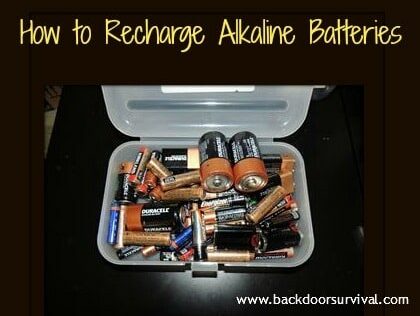

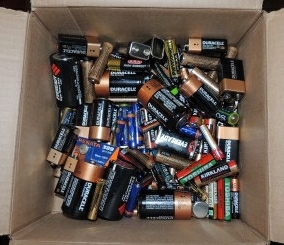
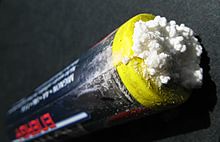
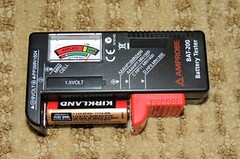
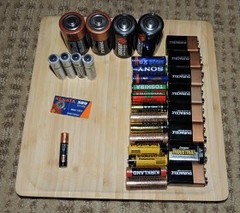

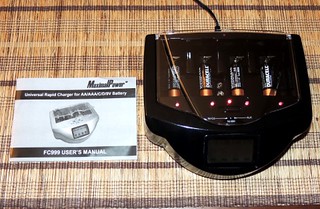
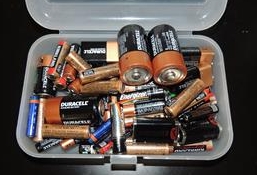
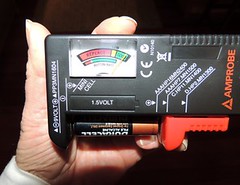
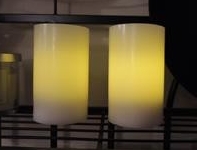









139 Responses to “How to Recharge Alkaline Batteries”
Why would anyone remove a drained battery and not recharge-put in recharer, plug in outlet.
Duh!!!
This is pure laziness on steroids.
I am sorry you think that is being lazy but so be it. That said, I work 12 to 14 hour days and I am old and exhausted. Your comment was quit hurtful. Gosh, I need my thick skin back!
Anyway, the whole point was to remind others to keep those batteries topped off and not to brow beat.
We love you Gaye. Thank you for being Human like the rest of us!
Yep. You do your level best and you still get hit with cheap shots. I get it. I just want you to know, Gaye, that you get a ten out of ten from me. Peace, my friend. Peace.
Q. Why would anyone remove a drained battery and not recharge-put in recharer, plug in outlet?
A. I seem to recall reading there’s a possibility they can explode if left unattended in a charger. You might not plan be around to pull it out when it’s fully charged back up? You might have other things to do, more important things to do?
Not everyone follows the ‘one is none’ mantra all the time.
If you’ve got a solar charger packed away in an EMP-proof container (I don’t)IMHO it’s not really a big deal to put off recharging a battery. A few hours in the dark prolly won’t kill ya. Besides, everyone’s got matches or a lighter if you *really* need to see in the dark.
The moon often makes for a pretty decent “flashlight”.
You own a car with working headlights.
You know your way around your house in the dark.
Those were just a couple of reasons I could think of off the top of my head. There are probably others besides pure laziness.
And, sometimes, it’s important to be lazy. To avoid prepper burnout, and all that.
Anyway, what did I do to prep this week?
I tested out various wool socks to see which I liked best, there were more differences than I thought.
Tested some of my extreme Winter gear in sub-zero temps, too.
Negative -20 degree temps this week, mid 50’s by next week.
Sounds like next week I get to test some more biking gear.
Well said, helot.
Also, for those of us concerned about EMP, it’s probably best not to have your batteries recharging at the time of an event, so not leaving your batteries in even a fancy trickle charge capable unit is a smart move. NiCd and NiMH batteries are pretty much EMP proof, but not sure what would happen at the time of an event to the charger and what it might do to your rechargeables.
For non electric light I keep a few container candles around the living room and have matches handy as well. And recently I got another set of UV Paqlites which are really useful as night lights, but can be handy if the power goes out…you just leave them in the sun, or even just under a lamp and when the lights go down (or out) the UV Paqlites start glowing. Not enough to read a book by, but enough to see obstacles in the dark of night.
Or for Mythbuster fans, try a pirate’s eye patch. 😛 No, seriously, it seems that pirates wore the eye patches for boarding actions…Ever walk into a dark room from bright sunshine? Can’t see much for a while, and that would have been deadly for the pirates, so they kept one eye in the dark (under the patch) so they would be able to see as they went down into the hold and took off the patch, or moved it to the light adjusted eye. Great tip for post SHTF mercenaries. 😉
In personal prepping news, I bought an AeroGarden Bounty off the ads here and loved it so much when I got an ad for a discounted second unit, I ordered that too! That took care of the last of my Christmas money, but what the heck…fresh salad fixings all winter long is a big morale booster, and not all disasters will involve the loss of the grid (pandemic comes to mind immediately.) Best feature of the new units: LED lights. The old AeroGarden units had fluorescent grow lights that had to be replaced every 4 to 6 months. The LED panels are good for 5 years on these new units! 🙂
I just did an inventory of all my preps and listed where everything is stored. Typed up these pages for quick reference. Decided to do this when I was looking for something and searched multiple places till I found it, hate being disorganized! My daughter thinks I’m obsessed 🙂
I took it one step further–with 6 BOBs in a room off the garage, it was impossible to get quickly an item if needed, even with the tags identifying what is there..like defense, lighting, etc.
So I spent a couple hours listing alphabetically the items in all 6 bags.
Now, easy to find a-z.
I am active in a coalition against Human Trafficking and this week I donated many boxes of kitchen supplies and food items to 4 young men who had been relocated and were victims of trafficking. I had been concentrating on organizing my storage area so it was quite easy to see exactly what I had stored and could provide to them. It had also given me the push I needed to tame remaining chaos in my basement so I can provide help when needed.
It has been very cold and snowy in my neck of the woods so I’ve had extra time to hunker down and organize supplies. I’ve also organized articles and clippings on preparedness, survival guides, essential oils and shelf ready cooking into binders so I can actually find things when needed – what a concept!
Looking forward to Spring!
I have been using the standard rechargeable batteries for decades and when you had the article on the Alkaline rechargers some time back I bought one and now keep the Alkaline batteries recharged for many, many more hours of use. I found that the Copper Top Alkaline last the longest and recharge the best, The Bunny not so much. I adapted my Alkaline charger to run off the solar battery system so will be able to charge even in power outages.
The Eneloops are the best rechargeable ones and well worth the price.
Just this week I saw piece on the local news where you could make an appointment with the local Red Cross to come to your home and check your smoke detectors. A lot of people dont know that smoke detectors are just good for 10 years, then even with good batteries, they wont work. The Red Cross with replace (for free) up to 10 detectors.
If your smoke detectors are less than 10 years old, remember to change the batteries twice a year. When you turn your clocks forward and back is a good reminder.
John R. Your advice is actually the opposite of what this article is about. You recommend wasting money by automatically changing batteries every 6 months without even testing them. Then wasting more money changing smoke detectors every 10 years without testing them either. I have 2 smoke detectors that are over 20 years old and still work and still sound when tested. The batteries last several years without problem. The last time it chirped, I tested both batteries. One was still deep in the good/charged range. The other just barely touched the “low” range. My CO meter purchased new January 2015 just got a new battery in October 2019. I keep written records.
I actually just spent a week rotating everything! Now I know what I have and what I need to replace or add more of. It was kind of exhausting. I think I will take a week off of prepping! My kids think I am a slavedriver, and my husband is amazed at what I have managed to accumulate over the last year with the little money we had. Also just put in my order for my garden seeds and plants. Waiting eagerly for spring!
I have a Battery Master CL 444 battery charger but I lost the power supply module. Do you know what the power requirements are and if so is the center pin + or – ? I searched the internet but was unable to find any information.
I used a charger that’s suppose to self adjust to the type of battery. Well I had put in two regular batteries one charges so I took it out added another. The other two were almost charged than bam one exploded. I unplugged it fast as I could and cleaned it up after it sat a few. I wont bother doing that again.
The Maximal Power charger requires that you move a switch to indicate the battery type (alkaline or rechargeable for example).
What an awful experience for you. What brand of charger were you using? I was planning to test other brands and want to stay away from any that are problematic.
If they would make one of these a solar unit I would buy one. I think that solar is the only way to go. The sun is always there but the grid probably won’t be.
eBay sells many flexible solar chargers cheap….just cut the cord on your charger and wire the solar charger to it…that is what I did works great….it slow charges the batteries so no leaking so far. A new AA reads 1.59 volts, I get about 1.55 volts on a solar recharged battery…2 days of sunlight will charge 4 ea AA batts using my 12 volt solar panel it measures 4″ x 14″ approx. $19.99 on eBay. I have one on my diesel truck as well it keeps the batts full…I use boron and distiller water mix to prolong the life…3 years old now and still reading 14.6 volts. It read 14.3 before I topped it off with the distiller water and boron mix.
The boron is a mild acid that prevents sulphides from forming and killing the battery. A low charge allows these sulphides a to form and build up.
Do not use tap water….it has minerals that build up and kill the battery.
I read your article several times. I have two grandsons who go thru batteries over and over. Like you I had a bunch of old dead ones lying around. I decided to try both the Maximal Power FC999 charger and the meter / tester. I had them shipped to me at work. I wanted to test it out. We have a bucket or pail that is full of old dead batteries of all sizes for proper disposal. I picked out 4 AA’s dead by meter test and charged them until they showed OK. Checked them again with the meter. They now show high end of good on the meter. I also found when testing for others to charge there were a lot of batteries that showed good on the meter. And OK in the charger. I have 20 AA that I took home and gave a friend 20 AA’s also. Still charging as I type this. The charger and meter won’t take long to pay for itself at this rate. I keep mining the bucket for AAA, AA, C, and D’s good and those needing charged. The charger only showed 1 battery as BAD so it went back in the bucket. Long story short. Thank you for not only useful information but $$$ savings too.